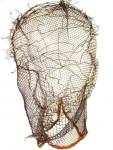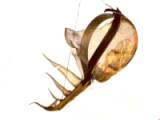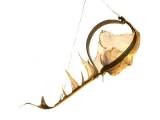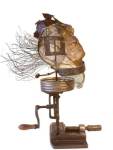| Unexpected Attractions |
| Kim Becher |
| Texts Home |
In a world that seems increasingly hostile to fortuitous encounters, Karen Bamonte’s sculptural pieces consisting of wire heads and faces offer a refreshing perspective. They embody a sense for the contingent, exploring the boundaries of what is creatively possible by listening to the potential of materials - generating ‘sense’ from ‘sensitivity’ |
|
The artist often uses very light and almost membrane like wire mesh that embraces the empty interior space of the heads. This choice of materials also adds to their vivacity and their sense of ‘belonging’ to the space around them. Contrary to heavy materials frequently used in traditional sculpture, aiming at immortalising historical or mythical figures and consequently disregarding the ‘tangible’ space around them, these pieces seem to be in dialogue with what surrounds them, almost inviting the space into them. |
| Texts Home |
|
The artist seems to have a special affinity with these materials and objects, treating them with a gentle delicacy yet urging them to betray their secrets. The finished works don’t function as mediators (of ideas/contents), to be understood or decoded by an informed spectator. Rather, they develop an inner kind of potential, which can be felt or understood on an emotional, sensorial level, but which intrigues the mind as well. |
|
| Texts Home |
Despite all the juxtaposition of materials, there is no obvious desire for the absurd involved. With these pieces, the fundamental movement between the spectator and the work is one of attraction, not alienation. This doesn’t mean of course there is nothing disconcerting about them. Being attracted, one becomes emotionally involved and at the same time invited to adopt a vulnerable, non-complacent attitude if one wishes to discover both the delights and dangers within the object of attraction. |
|
Kim Becher |
| Texts Home |
 One significant aspect of the series called "The Unknown Roman", is the relationship with "found objects". The combination of divergent elements brings a kind of tension to the work and breathes life into it. What is fascinating is the way the artist enters into a dialogue with these objects, the way she lets them into her world and re-introduces them into ours.
One significant aspect of the series called "The Unknown Roman", is the relationship with "found objects". The combination of divergent elements brings a kind of tension to the work and breathes life into it. What is fascinating is the way the artist enters into a dialogue with these objects, the way she lets them into her world and re-introduces them into ours. For instance, Icarfish, with its combination of elements: the industrial zipper as an unusual skeleton, holding everything together; the mesh implying a kind of skin adapted to aqueous or airy surroundings, and the thoughtful ‘ethereal’ facial expression. Through the process of oxidation followed by contact with fire, there emerges a light golden color with subtle shades and tints. (In much of this work, a lot of details and materials are damaged through scratching, cutting and burning, leaving very few perfect surfaces which could potentially turn them into lifeless utilities.)
For instance, Icarfish, with its combination of elements: the industrial zipper as an unusual skeleton, holding everything together; the mesh implying a kind of skin adapted to aqueous or airy surroundings, and the thoughtful ‘ethereal’ facial expression. Through the process of oxidation followed by contact with fire, there emerges a light golden color with subtle shades and tints. (In much of this work, a lot of details and materials are damaged through scratching, cutting and burning, leaving very few perfect surfaces which could potentially turn them into lifeless utilities.) These heads and faces feel ‘human’ because of their many layers and their multi-dimensionality; it’s as if they’re trying to make some sense out of the different experiences, injuries, struggles and vital impulses that constitute their ‘being in the world’. They are being attributed the same kind of complexity as human souls. One could say they express a sense of identity. Identities are temporal and involve a sense of transience. This is very human indeed, to look for something stable but in the process conjuring up the forces that will undo this stability. The heads, as well as a lot of other work by this artist without specific human characteristics, reveal considerably more about the human condition than most traditional portraits.
These heads and faces feel ‘human’ because of their many layers and their multi-dimensionality; it’s as if they’re trying to make some sense out of the different experiences, injuries, struggles and vital impulses that constitute their ‘being in the world’. They are being attributed the same kind of complexity as human souls. One could say they express a sense of identity. Identities are temporal and involve a sense of transience. This is very human indeed, to look for something stable but in the process conjuring up the forces that will undo this stability. The heads, as well as a lot of other work by this artist without specific human characteristics, reveal considerably more about the human condition than most traditional portraits. This implies a second movement, whereby one engages in a kind of dialogue or opening up to the inner complexity and emotional depth of the work. This ‘relationship’ of the spectator to the work is not mediated by any kind of symbolist or conceptualist code. Instead, these objects were made in a lively conversation between all the senses, and through an attentive and responsive spirit.
This implies a second movement, whereby one engages in a kind of dialogue or opening up to the inner complexity and emotional depth of the work. This ‘relationship’ of the spectator to the work is not mediated by any kind of symbolist or conceptualist code. Instead, these objects were made in a lively conversation between all the senses, and through an attentive and responsive spirit.